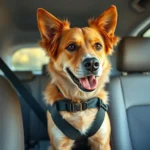
The bond between dogs and humans is one of the most beautiful relationships in the animal kingdom, particularly when it involves infants. Many parents and pet owners often wonder: are dogs protective of babies? This concern is not just about the love that dogs can show; it is about the instinctual behaviors that drive them to protect the most vulnerable members of the family. Understanding this dynamic is crucial for ensuring safety and harmony in a household that includes both dogs and babies.
Dogs are not only companions; they can become guardians, especially when it comes to the little ones in our lives. However, this protective behavior does not manifest in the same way across all breeds or individual dogs. Factors such as breed characteristics, training, and personal temperament can greatly influence how a dog behaves around babies.
Understanding Dog Behavior
Basic Instincts of Dogs
To comprehend whether dogs are protective of babies, we first need to understand their basic instincts. Dogs are pack animals by nature, which means they thrive in social structures. This pack mentality often translates into a protective instinct, where dogs feel a responsibility to guard their family members, including infants.
Territorial behavior is another instinct that can influence a dog’s protective nature. Dogs may see a baby as a new member of the pack that needs defending. However, proper socialization is crucial; dogs that are well-socialized with various people and experiences are more likely to exhibit gentle and protective behaviors toward infants.
Types of Dog Temperaments
Not all dogs are created equal when it comes to temperament. Some dogs are naturally gentle and nurturing, while others may be more aggressive or timid. Understanding these different temperaments is essential for predicting how a dog will behave around a baby.
Gentle breeds like the Golden Retriever or Labrador are often more inclined to be protective and nurturing. On the other hand, breeds with aggressive tendencies may be less predictable. Recognizing your dog’s temperament can help you take the right precautions and training measures to foster a safe environment for babies.
The Protective Instinct of Dogs
Historical Context
Historically, dogs have served as protectors and companions to humans. From herding livestock to guarding homes, dogs have always had a role in the family unit. This long-standing relationship has cultivated a natural instinct in many breeds to protect not just their human companions but also the vulnerable, such as children.
From ancient times, dogs have been depicted as guardians in various cultures, emphasizing their role as protectors. This historical context helps us understand why many dogs, especially those bred for protection, may instinctively watch over babies.
Signs of Protective Behavior
The protective instinct in dogs can manifest in several ways. Recognizing these signs is crucial for parents.
- Body Language Indicators: A dog may growl, bark, or position itself between the baby and an unfamiliar person or object. These actions indicate that the dog is on alert and ready to defend.
- Protective Actions: Some dogs may take it further by alerting their owners to potential dangers or even attempting to guard the baby from perceived threats.
Understanding these signs can help parents gauge their dog’s protective instincts and manage situations involving babies effectively.
Factors Influencing Protective Behavior
Breed Characteristics
Certain breeds are more predisposed to protective behaviors. For example, German Shepherds and Rottweilers are often recognized for their strong protective instincts. These breeds have been historically used in roles such as police and guard dogs, which influences their behavior in family settings.
Conversely, some breeds may not exhibit strong protective instincts. Breeds like the Beagle or Cavalier King Charles Spaniel, while affectionate, may lack the protective drive that characterizes other breeds. Understanding these characteristics can help parents choose the right dog for their family.
Early Socialization and Training
Early socialization is critical in shaping a dog’s behavior around babies. Introducing dogs to infants from a young age helps them become accustomed to their presence and sounds. This exposure can reduce anxiety and promote protective behaviors.
Training techniques such as positive reinforcement can also be effective. Rewarding a dog for calm and gentle behavior around a baby can reinforce these traits. A well-trained dog is more likely to exhibit protective instincts in a safe and non-aggressive manner.
Individual Dog Personality
While breed tendencies play a role, individual personality is equally important. Genetics and upbringing significantly influence a dog’s behavior. For instance, a confident, well-adjusted dog may be more protective than a timid one, regardless of breed.
Case studies of individual dogs can provide insight into this dynamic. For example, many families have shared stories of their Labrador retriever acting as a gentle guardian for their newborn, while others have experienced challenges with more anxious breeds. Understanding individual dog personalities can guide parents in managing interactions between dogs and babies.
Ensuring Safety Between Dogs and Babies
Creating a Safe Environment
When babies are around dogs, creating a safe environment is paramount. Here are some tips for baby-proofing your home while considering your furry friend:
- Designate Safe Spaces: Establish areas in your home where the baby can play safely, away from the dog. Similarly, designate areas where the dog can retreat if they feel overwhelmed.
- Supervision is Key: Always supervise interactions between dogs and babies. This ensures that both parties feel safe and protected.
Supervision and Interaction
Monitoring dog-baby interactions is essential to fostering a positive relationship. Here are some guidelines:
- Observe Body Language: Watch for signs of stress or discomfort from either the dog or the baby. If a dog appears anxious, it may be best to separate them.
- Engage in Positive Activities: Encourage gentle interactions, such as allowing the dog to sniff the baby’s feet or hands while rewarding calm behavior.
By facilitating positive experiences, parents can help build a strong bond between their baby and their dog.
Recognizing Red Flags
Not all dogs may be suitable around babies. Recognizing red flags can prevent potential issues:
- Aggressive Behavior: If a dog exhibits signs of aggression, such as snapping or growling, it may not be a good fit for a household with a baby.
- Overly Timid Dogs: Conversely, a dog that is overly timid may also pose challenges, as they may react unpredictably when frightened.
In such cases, seeking help from a professional trainer or behaviorist can provide valuable guidance.
Benefits of Having Dogs Around Babies
Emotional and Psychological Benefits
The presence of dogs can offer profound emotional and psychological benefits for babies and their families. Growing up with a pet can teach children about responsibility, empathy, and compassion.
Moreover, dogs often provide companionship, reducing feelings of loneliness and promoting emotional well-being. Research shows that children who grow up with pets tend to develop stronger social skills and emotional intelligence.
Health Benefits
The health benefits of having dogs around babies are supported by various studies. Pet ownership has been linked to lower stress levels, which can positively impact both parents and children.
Furthermore, exposure to dogs during infancy can boost a baby’s immune system, reducing the likelihood of developing allergies. This exposure can lead to healthier children who grow up with a strong bond to their furry friends.
Conclusion
In summary, the question of whether dogs are protective of babies encompasses a range of factors, including breed characteristics, individual temperament, and training. Understanding these dynamics is essential for parents and pet owners seeking to foster a safe and harmonious environment.
The bond between dogs and babies can be incredibly rewarding, offering emotional, psychological, and health benefits. By considering your dog’s temperament and implementing proper training and supervision, you can ensure that both your dog and baby thrive in each other’s presence.









